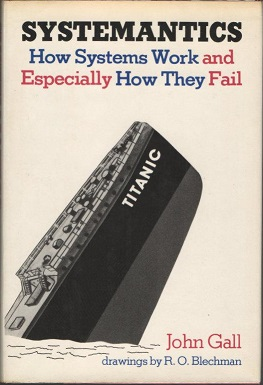Your health scoring system is probably overly complex.
In 1978 John Gall published a notable book on systems called Systemantics. A bit odd since he was not a systems expert. He was a pediatrician.
But in the book, Gall makes the following assertion:
“A complex system that works is invariably found to have evolved from a simple system that worked. The inverse proposition also appears to be true: A complex system designed from scratch never works and cannot be made to work. You have to start over, beginning with a working simple system.”Systemantics: How Systems Work and Especially How They Fail – by John Gall
Pretty insightful.
This has become known as Gall’s Principle.
Gall’s Principle got me thinking about the Holy Grail of customer success – the customer health score.
The vision is simple.
A health scoring system combines data points from support cases, call and email interactions, product usage stats, online knowledge base search queries, academy learning usage, and more.
Weightings are applied to each data point, and voila. You have a single metric that tells you which customers are in good shape and which need intervention.
Sounds simple. And rational.
But in all my travels, I can count on one hand the number of times I’ve seen a health score working in the wild.
Here are a few reasons why:
Health scores aren’t actionable. Given a health score between zero and 100, what actions should a team member take?Health scores are often based on incorrect premises. For example, more support cases aren’t necessarily bad, but many would assume the opposite, that high case volume is a proxy for a dissatisfied customer. It’s not usually the case (the dissatisfied customers aren’t contacting you at all).Health scores are overly complex. Unique weightings for different types of data give a sense of false precision. Once combined, the algorithm becomes a black box to end users (further exacerbating bullet #1). Health scores aren’t revised often enough. The effort to design them is monumental. Once implemented, they are revised infrequently.
Beyond all this, there are insights we can’t get from our existing data.
For example, a new executive sponsor enters the picture. They prefer a competitor’s product. CS teams may need a new process to manually track stakeholder relationships and their sentiment towards us.
So if health scores are too complex to be helpful, what’s the alternative? After all, we still need a data-driven approach to managing customers.
Here’s how I think about it.
Start with a simple, insight-driven system.
Identify the top three root causes of customer churn.
For example, stakeholder turnover–a notorious churn culprit in the B2B world. Or failure to launch. Product fit. Incompatible use cases. Third-party integration issues. Etc.
You know what the failure modes of your customers are. If you don’t, talk to a few canceled customers and find out. Use the five whys and form a perspective.
Next, identify three characteristics of healthy, happy, and renewing customers. What do they have in common?
Might be the inverse of the list of failure modes above. Strong sponsors. Trained admins. 3rd party integrations working. Timely onboarding. Etc.
Again, you know what your top customers have in common. If not, you should. Go talk to them and find out.
You now have a strong perspective on why customers succeed and fail. Now go find data points that are good proxies for these factors.
In some cases, it’s easy. If adoption is a factor, find the one proxy metric in your usage data that indicates a customer will be successful.
Sometimes, you may need to create a new process to capture the data you need.
If a strong product admin is key to retention, track this role for every customer account. Who are they? Are we in contact with them? Are they experienced? Have they been onboarded and trained?
Use existing data where you can, as long as there is a good correlation to the retention factor in question. Collect new data points where needed.
Score each customer across every retention risk factor, and design a strategy to mitigate each.
Make a prescriptive, detailed playbook for each strategy that team members can follow. Train them on it.
Once implemented, leaders should review quarterly and ask, “Are we consistently doing the mitigation activities we designed? And are they working?”
Measure and iterate them constantly.
We’re awash in data, but our metrics are often too clever for their own good. And they are too generic, which causes our mitigations to be too generic.
The key to all of this is specificity. The more specific you can be, the more successful you will be in areas you can make an impact on retention.
To that end, you can apply these concepts to smaller segments within the customer portfolio. Commonly, different factors impact SMB and Enterprise retention. The same goes for different industries and other segmentations you may use.
This approach will make you more effective at driving Net Retention and increase your ability to report on activity and results.
It’s also easier to communicate your plan to peers, exec leadership, and the board. There is no black box.
Start with a simple system. Be specific. Iterate and build on what’s working.
Make John Gall proud.
Where would a simple system serve you better than a complex system you’re running or designing today?
✌️

